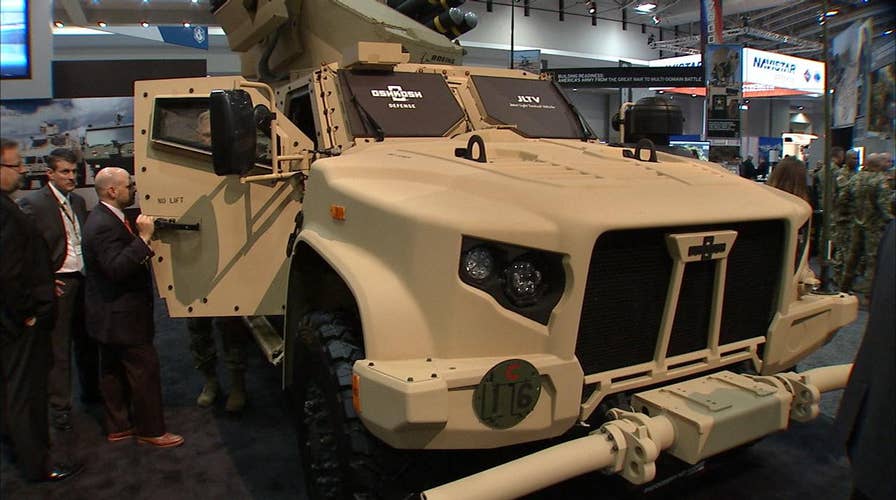High-tech military vehicles on display at AUSA 2017
Fox Firepower: Defense Specialist Allison Barrie shares her top picks of high-tech military vehicles on display at AUSA 2017 including a fuel-cell powered Chevy truck and a self-driving Polaris MRZR.
Armored vehicles with laser weapons, silent motorcycles that can run on jet fuel, self-driving ATVs and futuristic Chevy trucks - there were a lot of eye-popping vehicles in the nation’s capital this week.
At the annual Association of the United States Army (AUSA) exhibition, US Army Soldiers and their families get the chance to explore innovation from around the world created for future combat.
Many vehicles from giant tanks through to tiny rolling surveillance robots were on display this year.
Here are four of the most popular draws throughout the week.
JLTV – Advanced armor plus laser
As far as draws go, it is hard to beat a vehicle responsible for keeping soldiers safe – and one that now has a laser weapon.
Oshkosh is celebrating its 100th birthday this year and it went big on the AUSA floors. The company featured not just one of their Joint Light Tactical Vehicles (JLTV), but three – and three mounted with a serious amount of firepower that no enemy would ever want to face.
One JLTV was equipped with a Boeing Compact Laser Weapon System (CLWS) and a Kongsberg Protector LW 30 Remote Weapon System with a M230LF cannon.
Another JLTV featured the Boeing Maneuver Short Range Air Defense (SHORAD) Launcher including a M3P .50 cal machine gun and a M299 launcher with four Longbow Hellfire missiles.
JLTV General Purpose equipped with Rafael Samson RWS Dual Stabilized Remote Weapon Systems with M230 LF, and the Trophy Light Active Protection System.
One of the popular features from a soldier’s point of view is that no matter the terrain, the ride is surprisingly smooth, thanks to OshKosh’s TAK-4i suspension system. The JLTV can tackle extreme terrain leveraging design like the 20 inches of wheel travel.
Families can take comfort in the advances for protection like the MRAP-level underbelly to protect against improvised explosive devicesand the vehicle wide armoring that provides enhanced protection against blasts and ballistic threats.
The Core-1080 Crew Protection System provides a very comprehensive advanced approach to crew protection. Features like the capsule design, energy absorbing floor, seats and even floor mats all enhance protection and help to keep American soldiers safe.
SilentHawk Motorcycle
Tucked away in the sprawling, massive AUSA floors was the very impressive SilentHawk - a hybrid-electric, two-wheel drive all-terrain motorcycle. Not only can it handle very tough terrain, it can do so while running nearly silently.
The quiet operation could provide a range of advantages to the Army like the element of surprise and avoiding detection. And a bike that can handle challenging off-road effortlessly gives teams advantages as well. For example, teams would have the option to travel unexpected routes to targets.
At 350 pounds, the bike is lightweight but it can reach speeds of 80 mph and run for up to 170 miles without refueling.
It has a two-mode hybrid propulsion system. The battery-only mode provides the ultra-quiet operation. SilentHawk can travel two hours in this quiet mode on a single charge.
The multi-fuel mode can be used when long-range is needed. The bike is compatible with gasoline, JP-5, JP-8, Jet-A1, propane and AVGAS so there are lots of fuel options to harvest along the way during a mission.
There’s also an interactive graphical interface to display mission data and system status and integrated mount and power for an Android Tactical Assault Kit (ATAK).
SilentHawk is currently in development with Alta Motors and Logos Technologies.
PODCAST: LEARN TO DRIVE YOUR ATV LIKE SPECIAL FORCES
MRZR-X
The intense competition to win a SMET contract served as a backdrop and the subject of much conversation at AUSA. Nine companies have submitted ten robots for selection as an Army SMET – a robot that would serve alongside soldiers in Brigade Combat Teams.
The wildly popular Polaris Defense ATVs always draw crowds and this year there was also much curiosity surrounding the MRZR-X. This is the Polaris submission for SMET and unsurprisingly Soldiers and their families were fascinated by what a “thinking” MRZR ATV would be like.
Polaris kept the MRZR-X under wraps, but featured MRZRs that provide hints as to what a smart MRZR could bring to combat. We can expect the “brains” laid out in the Army requirements combined with the MRZR’s assets.
MRZRs can handle heavy off-roading in tough terrain. They have on-demand, advanced all-wheel drive with the already in-built smarts to automatically engage all four wheels and revert to two-wheels
The vehicles can reach speeds of about 60 miles per hour and deliver maximum agility. They are air transportable and quickly adaptable for different mission requirements.
The military regularly takes advantage of features like instant black out jump and go keyless ignition.
Find more detail on the mysterious MRZR-X here.
ZH2 Chevy truck
Another crowd favorite this year was a Chevy truck unlike any other.
This new General Motors prototype, known as the Chevrolet Colorado ZH2, runs on hydrogen fuel cells. It's based on a Chevrolet Colorado truck – but with lots of modifications for military purposes.
US Army TARDEC – renowned for their tank work – and GM have teamed up to explore a new method of power for Army vehicles. The prototype has been designed to deliver near silent operation and very hard to detect heat signatures.
How else is it different to a typical Chevrolet Colorado? For starters, it is reinforced inside and out. To tackle the sort of extreme terrain the military faces, it has a specially modified suspension.
And it doesn’t take gasoline. This one uses a futuristic fuel source that has often been thought to be dangerous. Hydrogen fuel cell tech is advancing rapidly – but is it stable enough and safe enough for Army use?

